Featured Testimonial About Creighton University

In gratitude, we dedicate this ship to the Creighton men and women in the armed forces, especially the gold stars who have died that we might live. God bless this ship and all who sail in her. Every Creighton heart sails with her to victory.
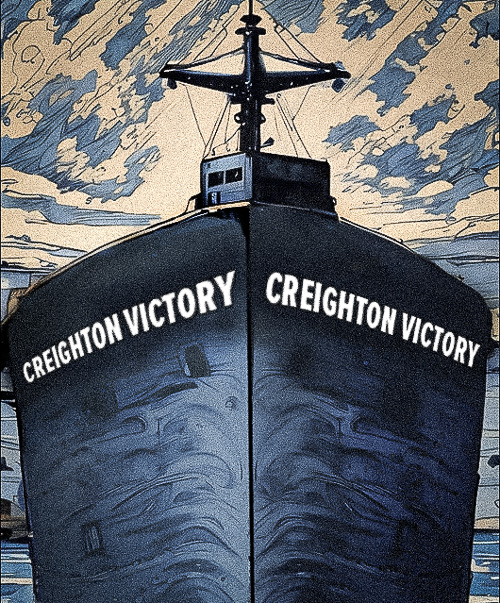
By Micah Mertes
Eighty years ago, in the spring and summer of 1945, the U.S. Navy christened and launched a 455-foot-long, 15,000-ton, 8,500-horsepower armed cargo ship named after Creighton University.
The S.S. Creighton Victory was more specifically dedicated to the 100 Creighton students or alumni who had been killed in the war by that point. The following summer, on July 4, 1946, the S.S. Creighton Victory embarked on a post-war reconstruction mission, with an interracial crew of “seafaring cowboys” delivering several hundred cattle to war-torn Europe.
This is the story of the WWII ship that carried Creighton's name.
* * *
The S.S. Creighton Victory was christened in Portland, Oregon, on March 21, 1945. The ship was one of a series going into service that year to be named after U.S. colleges and the 64th ship of its type to be built at the Oregon Shipbuilding Company. Designed by the U.S. Maritime Commission, the Victory ships replaced the older, less efficient Liberty vessels.
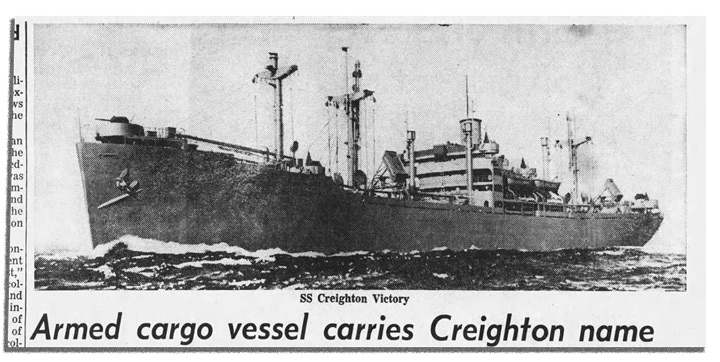
The speaker at the S.S. Creighton Victory’s christening was James Foley, BS’32, MD’32, a Portland physician and member of the Creighton Alumni Association. (Twenty Creighton alumni in the Portland area also attended the event.) Foley read a letter written by then-Creighton President the Very Rev. Thomas S. Bowdern, SJ.
“Creighton University sponsors with pride the good ship S.S. Creighton Victory. If we deserve this honor, we acknowledge that it has been earned for us by the 2,600 Creighton men and women in the armed forces. In gratitude, we dedicate this ship to them, especially the 100 gold stars who have died that we might live. God bless this ship and all who sail in her. Every Creighton heart sails with her to victory.”
Soon after, the S.S. Creighton Victory embarked on its maiden voyage, carrying 8,500 incendiary bombs for delivery in the Philippines. For the 15 months following its commissioning, the ship carried war material and troops to China, Okinawa, Singapore, the Philippines, India, Egypt, New Zealand and Danzig.
* * *
After the war, the S.S. Creighton Victory would fill a new role: livestock transportation.
On July 4, 1946, the vessel became one of 73 ships that the United Nations Relief and Rehabilitation Administration and the Church of the Brethren Service Committee employed to haul cattle to nations devastated by the war. The relief ships were crewed by Parry Navigation Co. The livestock were tended by volunteers, called the “seafaring cowboys.”
Peggy Reiff Miller, who has documented the definitive history of the seafaring cowboys, writes:
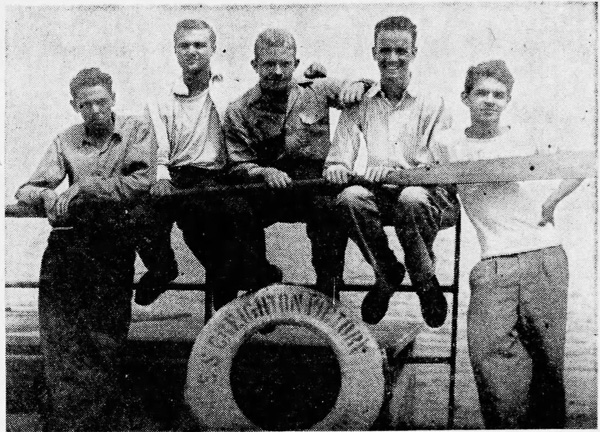
“They were students and farmers, bankers and preachers, laborers and teachers. They were Brethren, Mennonite, Catholic, Protestant, Amish, unchurched. Some sought adventure, some sought to serve people whose lives had been torn apart by war, some wanted to see firsthand what they had only read about or seen on film.”
From 1945 to 1947, more than 7,000 men from the U.S. and Canada transported nearly 240,000 animals over about 360 trips (to Albania, China, Czechoslovakia, Ethiopia, Greece, Italy, Poland and Yugoslavia).
From a 1946 call for volunteers:
“Applicants are wanted who are able and willing to care for livestock, are of good character, and who have a definite interest in helping rehabilitate Europe.”
For the S.S. Creighton Victory’s first relief trip, about 30 college students from across the country (none of them Creighton students, as far as we could tell) signed up to take 840 head of cattle to Danzig to feed starving Poles. That first trip (one of many) was a success, with only four of the 840 cattle not surviving the journey.
Up to that point, all ships had been segregated into Black or white crews. The ship named after Creighton was different. On that trip, about a third of the college students who volunteered were Black, and the ship was fully integrated, with no color line observed.
Following several more trips to Europe, the S.S. Creighton Victory was discontinued and put into dry dock, the latest member of the Navy’s “mothball fleet.”

* * *
With the outbreak of the Korean War, the S.S. Creighton Victory found a second life. In 1950, it was recommissioned to carry ammunition and other materials during the conflict. Its ports of call included Japan, several Pacific islands and Korea. The S.S. Creighton Victory also played an essential role in evacuating troops.
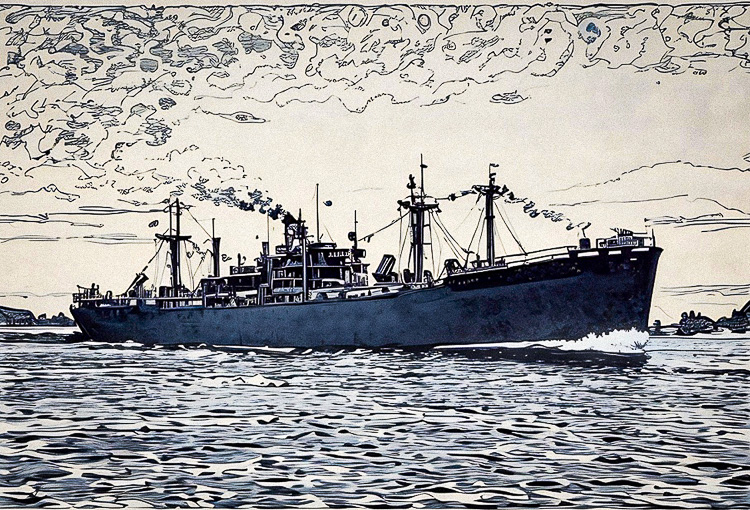
In 1951, Omahan Jerry Greenberg returned after his 14-month assignment as second mate on the S.S. Creighton Victory. Greenberg, whose cousins included two Creighton School of Medicine alumni, visited the University’s PR office to describe Creighton’s namesake ship.
“You’d see a lot of changes in her now,” Greenberg told the Creightonian.
Greenberg said that a handmade plaque hung in the officer’s room, telling of the ship’s launch and its connection to Creighton University. (The original plaque had apparently been stolen while the ship was in dry dock.)
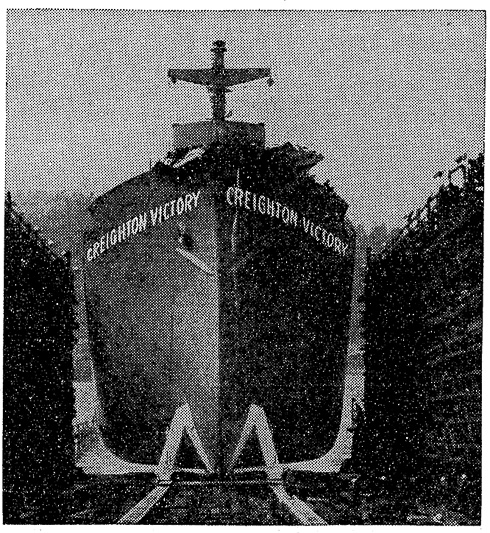
Following the Korean War’s end in 1953, the ship was once again decommissioned and placed in the Navy’s emergency reserve.
* * *
The final bit of news regarding the S.S. Creighton Victory comes from a 1953 report that ran in several newspapers:
TRANSPORTS COLLIDE
Two American military transports collided Friday night, five miles outside the entrance to Sasebo harbor, a U.S. naval base in southern Japan. No casualties were reported.
The Navy said the transport Creighton Victory sideswiped the transport Jumper Hitch and that the collision opened a six-foot hole in the Jumper Hitch’s bow.
The Creighton Victory continued on its voyage.
* * *
Sources: University Archives, Creightonian, Omaha World-Herald, Newspapers.com


